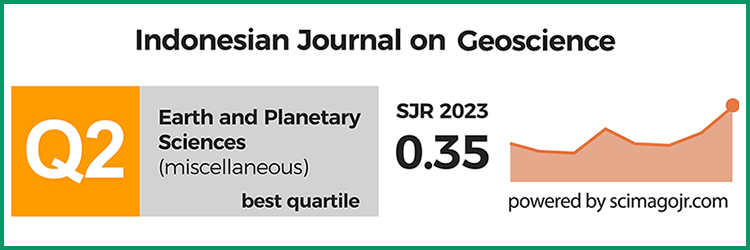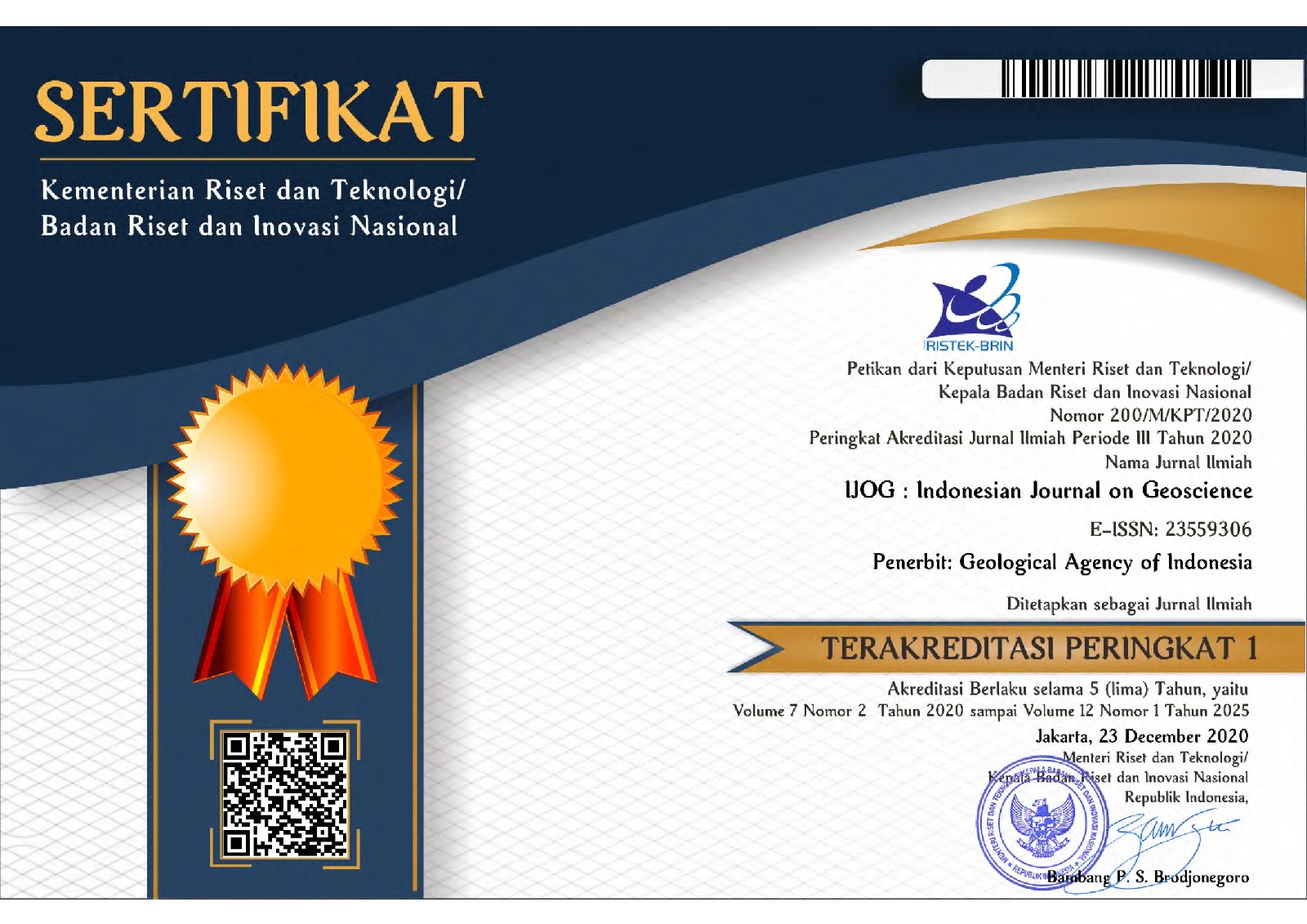Eo-Oligocene Oil Shales of the Talawi, Lubuktaruk, and Kiliranjao Areas, West Sumatra: Are they potential source rocks?
DOI:
https://doi.org/10.17014/ijog.1.3.135-149Keywords:
oil shale, alternative energy, effective source rock, lamosite, kerogenAbstract
To anticipate the increasing energy demand, additional data and information covering unconventional fossil fuels such as oil shale must be acquired to promote the usage of alternative energy sources to crude oil. The Talawi and Lubuktaruk regions situated within intra-montane Ombilin Basin, and the Kiliranjao assumed to be a small intra montane basin are occupied by Eo-Oligocene sediments of Sangkarewang and Kiliran Formations, respectively. Field activity, geochemical screening techniques, and organic petrographic analysis, supported by SEM mode, are methods used. Most of the oil shale sequence is typically of an organically rich-succession comprising predominantly well-bedded, laminated and fissile, brownish to dark grey organic-rich shale and mudstone rocks. The exinite macerals within oil shale comprise mainly Pediastrum-lamalginite with minor cutinite, resinite, liptodetrinite, sporinite, bituminite, and rare Botryococcus-telalginite. Therefore; the oil shale deposits can be described as “lamosites”. Minor vitrinite maceral is also recognized. TOC analysis on selected shale samples corresponds to a fair up to excellent category of source rock characterization. The hydrogen index (HI) for all samples shows a range of values from 207 - 864, and pyrolysis yield (PY) ranges from 2.67 to 79.72 mg HC/g rock. The kerogen is suggested to be of mixed Type II and Type I autochthonous materials such as alginite, with minor allochthonous substances. Oil samples collected appear to be positioned within more oil prone rather than gas prone. Thermal maturity of the oil shales gained from Tmax value and production index (PI) tends to show immature to marginally/early mature stage. A consistency in the thermal maturity level results by using both Tmax and vitrinite reflectance value is recognized. On the basis of SEM analysis, the oil shale has undergone a late eodiagenetic process. Thereby, overall, vitrinite reflectance agreeing with Tmax rates, are also consistent with the PI (production index) values and SEM result. By evaluating all the results of geochemical and organic petrological analyses conducted on shale lithologies (shale and mudstone), it can be concluded that the oil shales in those areas have a favourable potential for generation of shale oil or gas to be included as alternative energy resources in the future.
References
Bustin, R.M., Cameron, A.R., Grieve, D.A., and Kalkreuth, W.D. ,1985. Coal Petrology: Its Principles, Methods and Applications. Geological Association of Canada, Short Course Notes, 3, 2nd ed., 273 pp.
Cameron, N.R., Aspden, J.A., Suwarna, N., and Suharsono, 1981. The Geology of Ombilin Basin, Singkarak Block, West Sumatra. Unpublished Rept., P.T. Caltex Pacific Indonesia, Nov. 1981, Rumbai, Sumatra.
Cook, A.C., Hutton, A.C., and Sherwood, N.R., 1981. Classification of oil shales. Bull. Cent. Rech. Exploration-Production Elf-Aquitaine, 5, p.353-381.
Coster, G.L. de , 1974. The geology of the central and south Sumatra basins. Indonesian Petroleum Association, p.77-110.
Dyni, J.R. ,2004. Oil Shale. Energy Minerals Division. EMD Home > Technical Areas: Oil Shale, 10 pp. doi:10.1016/B978-008044410-9/50007-3
Espitalie, J., Laporte, J.L., Madec, M., Marquis, F., Leplat, P., Paulet, J. and Boutefeu, A., 1977. Methode rapide de caracterisation des roches meres, de leur potentiel petrolier et de leur degre d’evolution. Rev. Inst. Franc. Petrole, 32, p.1, 23-40. doi:10.2516/ogst:1977002
Foscolos, A.E., Powell, T.G., and Gunther, P.R.,1976. The use of clay minerals and inorganic and organic geochemical indicators for evaluating the degree of diagenesis and oil generating potential of shales. Geochimica et Cosmochimica, Acta, 40, p.953-966. doi:10.2516/ogst:1977002
Hermiyanto, M. et al. ,2008. Laporan penelitian geodinamika Cekungan Sumatra Selatan di daerah Sinamar, Jambi. Laporan internal PSG.
Heryanto, R., Suwarna, N., and Panggabean, H., 2002. The Lakat Formation in the Northeastern Flank of the Tigapuluh Mountains and Its Possibilities as a Source Rock.Proceedings of 30th Annual Convention Indonesian Association of Geologist and 10th Geosea Regional Congress on Geology, Mineral, and Energy Resources.
Hutton, A.C. , 1980. Organic petrology of some Australian and overseas oil shales. In: Cook, A.C. and Kantsler, A.J. (eds.), Oil Shale Petrology Workshop, Wollongong, 1980. Keiraville Kopiers, Wollongong, p.42-49. doi:10.1016/0166-5162(87)90032-2
Hutton, A.C., 1987. Petrographic classification of oil shales. International Journal of Coal Geology, 8, p.203.
Koning, T., 1985. Petroleum geology of the Ombilin Intermontane Basin, West Sumatra. Proceedings, 14th Annual Convention of Indonesian Petroleum Association, Jakarta, October, p.117-137.
ICCP, International Committee for Coal Petrology, 1963. Handbook, 2nd Edition, Centre National de la Recherche Scientifique, Paris, France.
ICCP, International Committee for Coal Petrology, 1971. International Handbook of Coal Petrology, 1st supplement to 2nd edition. Centre National de la Recherche Scientifique, Paris, France.
Peters, K.E., 1986. Guidelines for evaluating petroleum source rock using programmed pyrolysis. American Association of Petroleum Geologists, Bulletin, 70, p.1-36.
Rad,F.K., 1984. Quick Look Source Rock Evaluation by Pyrolysis Technique. Proceedings of 13th Annual Convention of Indonesian Petroleum Association, p.113-124.
Robert, P., 1981. Classification of Organic Matter by Means of Fluorescence: Application to Hydrocarbon Source Rocks. International Journal of Coal Geology, 1, p.101-137. doi:10.1016/0166-5162(81)90007-0
Sappal, K.K., 1986. Petrography of Collie Coal, Collie Basin, Western Australia. WAMPRI, 26, 202pp.
Silitonga, P.H. and Kastowo, 1995. Geological Map of the Solok Quadrangle, scale 1: 250 000. Geological Research and Development Centre, Bandung (2nd Edition).
Struckmeyer, H.I.M. and Felton, E.A., 1990.The use of organic facies for refining palaeoenvironmental interpretations.A case study from the Otway Basin, Australia. Australian Journal of Earth Sciences, 37, 321-370. doi:10.1080/08120099008727932
Suwarna, N. , Panggabean, H., and Heryanto, R., 2000. Penelitian Oil Shale Sumatera Bagian Tengah. Laporan Internal, PSG.
Suwarna, N., Heryanto, R., Hermanto, B., Sundari, D., and Panggabean, H., 2001. Paleontolgy and Fossil Fuel Study in Central Sumatera. Internal Report, PSG.
Suwarna, N., Panggabean, H., and Heryanto, R., 2001. Oil Shale Study in the Kiliranjao Sub-basin, Central Sumatera. Proceedings, IAGI and GEOSEA, Yogyakarta, Indonesia.
Widayat, A.H., Anggayana, K., Syafrizal, Heriawan, M.N., Hede, A.N.H., and Al Hakim, A.Y., 2013. Organic Matter Characteristics of the Kiliran and Ombilin Oil Shales. Procedia Earth and Planetary Science, 6,p. 91 – 96. doi:10.1016/j.proeps.2013.01.013
Wilson, M.D. and Pittman, E.D.,1979. Authigenic clays in sandstone: Recognised and influence on reservoir properties and palaeoenvironmental analysis. Journal of Sedimentary Petrology, 47, p.3-31.



















